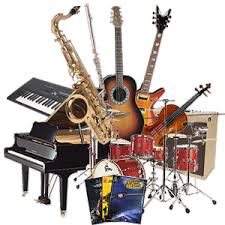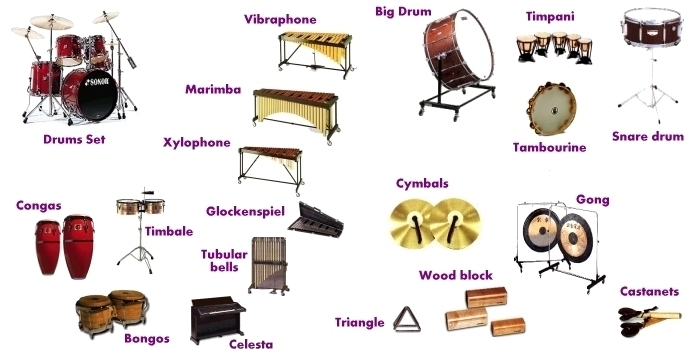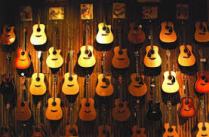MUSICAL INSTRUMENTS Please visit my Vimeo page if you are looking for how to maintenance certain instruments.
Please visit my Vimeo page if you are looking for how to maintenance certain instruments.
Click here for some good YouTube vids about music instruments
STRINGS FAMILY <— click here to hear/watch
 Violin-This is the baby of the family. This instrument plays in treble clef (or G Clef) and is one of the higher sounding string instruments. This instrument has also been referred to as the fiddle when playing country and types of folk music. The violin can be plucked or bowed. The violin is the string family’s most recognizable orchestral instrument.
Violin-This is the baby of the family. This instrument plays in treble clef (or G Clef) and is one of the higher sounding string instruments. This instrument has also been referred to as the fiddle when playing country and types of folk music. The violin can be plucked or bowed. The violin is the string family’s most recognizable orchestral instrument.
 Viola– This is the sister of the family. This instrument play in alto clef (or C Clef) and is the middle voiced instrument. Like the violin, the viola can be plucked or bowed. It is slightly larger in size and more mellow in tone that its sister instrument. The depth and richness of the viola adds to the orchestra’s sounds and is vital for string ensemble and quartets.
Viola– This is the sister of the family. This instrument play in alto clef (or C Clef) and is the middle voiced instrument. Like the violin, the viola can be plucked or bowed. It is slightly larger in size and more mellow in tone that its sister instrument. The depth and richness of the viola adds to the orchestra’s sounds and is vital for string ensemble and quartets.
 Cello– This is the mom of the family and represents the tenor voice of the orchestra. It produces warm sounds and low tones. Unlike the violin and viola, the cello is supported on the floor by an end-pin, while the seated performer steadies the instrument with their knees.This instrument plays primarily in bass clef and is the instrument closest to the human voice. The cello uses a french style bow like the violin and viola.
Cello– This is the mom of the family and represents the tenor voice of the orchestra. It produces warm sounds and low tones. Unlike the violin and viola, the cello is supported on the floor by an end-pin, while the seated performer steadies the instrument with their knees.This instrument plays primarily in bass clef and is the instrument closest to the human voice. The cello uses a french style bow like the violin and viola.
 Double Bass– This is the dad of the family. This instrument can reach heights of 6 ft tall and plays in the bass clef. It is called the double bass as it sound two octaves down from where it reads. It uses a German or French style bow and can be plucked. The bass plays many different styles of music including classical, jazz and rock.
Double Bass– This is the dad of the family. This instrument can reach heights of 6 ft tall and plays in the bass clef. It is called the double bass as it sound two octaves down from where it reads. It uses a German or French style bow and can be plucked. The bass plays many different styles of music including classical, jazz and rock.
Bass bows- Double bass uses two different bows depending on how the play chooses to hold the bow. There is the French style that is align with the other viol instruments and the German bow, which adapts more to the contoured movement of the wrist. Both are utilized in orchestras today.


Guitars- Strings and Fretted
Considered one of the most popular instruments, the guitar can be played acoustic or electric, plucked, strummed, picked and sometimes used for percussion. The strings are often nylon or metal.
 Electric vs. Acoustic– Many guitarist will often play both. However, usually the style of music dictates what instrument is needed. Electric guitars are often amplified, therefore giving a louder sound and can often use effects like distortion and other pedals to modify the sound. Acoustic guitars were the first type of guitar and are often made hollow, so the sound can resonate through the tone hole. Many guitar manufacturers make acoustic guitars with electronics in them, so guitarists can have the best of both worlds.
Electric vs. Acoustic– Many guitarist will often play both. However, usually the style of music dictates what instrument is needed. Electric guitars are often amplified, therefore giving a louder sound and can often use effects like distortion and other pedals to modify the sound. Acoustic guitars were the first type of guitar and are often made hollow, so the sound can resonate through the tone hole. Many guitar manufacturers make acoustic guitars with electronics in them, so guitarists can have the best of both worlds.
Harp-  There are different types of harps, big ones, small ones, ones with pedals. Most commonly you’ll see pedal harps that are used in orchestras. Harps often have different colored strings to let you know what note you are playing.
There are different types of harps, big ones, small ones, ones with pedals. Most commonly you’ll see pedal harps that are used in orchestras. Harps often have different colored strings to let you know what note you are playing.
WOODWIND FAMILY<—click here to hear/watch
Flutes– There are many types of flutes out there, wooden ones, glass ones, etc. Some of the first were made from bones. I’ve even seen them made out of carrots. However, when we think of flute, we think of the metal one that has evolved to playing in the orchestra.

Piccolo– Is a small version of the flute but typically plays much higher and is used for special songs.
 Recorder– Is one of the most used instruments in music classrooms, as it is traditionally easy to teach and allows students to learn more about pitch and playing together as a group.
Recorder– Is one of the most used instruments in music classrooms, as it is traditionally easy to teach and allows students to learn more about pitch and playing together as a group.
Clarinets- The clarinet has evolved through out the years. The clarinet is often made of wood or plastic today and utilizes keys and pads just like the flute. However, the clarinet has a bell on the end and uses a little piece of bamboo called a reed to help it produce sound. The clarinet comes in several sizes including the Eb Clarinet (smallest), Bb Clarinet (most common), Alto Clarinet (Bassett Horn), Bass Clarinet, and Contra Bass (rare)
Double Reeds- Double Reeds are most commonly called the Oboe, English Horn, Bassoon and Contra Bassoon. These instruments use two special reeds placed together to make their sounds.
Saxophones– The saxophones are often thought of as brass instruments, but because it uses a single reed like the Clarinet, it is part of the Woodwind family. Saxophones come in all types of voicing, but the most common are the alto saxophone and the tenor saxophone.
BRASS FAMILY <–click to hear/watch
Higher Brass- When I say “higher” I say, higher in sound. Horns have been used for so long. They were made from animal horns and then replicated to metal, used for hunting or warnings, and today we still use them for many purposes. Mostly brass instruments are essentially pipes fitted together and air is blown through. The difference in pitch is achieved by tightening or loosening the lips and rhythm is created by air/tongue inflections. The trumpet is the highest sounding, its cousin the cornet, a bit smaller in size. The French horn is played with the right hand inside the bell to cup or mute the sound.
Lower Brass- lower brass meaning lower in pitch. Often these instruments play in bass clef, with the exception of the Baritone/Euphonium, which can also play in treble. The trombone utilizes a slide in order to create different pitches. The Baritone/Euphonium are fairly similar in looks, however, you will notice in the pictures, the baritone is a bit thinner at the top of the cone. These can come with 3 or 4 valves similar to the trumpet. The tuba is one of the largest brass instruments and lowest and often plays the bassline. However the sousaphone was developed for marching bands by John Phillip Sousa, as it was too cumbersome to walk with a tuba. Sousaphones are still used in marching bands today.
PERCUSSION FAMILY <—-click here to hear/watch
Percussion instruments were truly the first instruments as we can utilize everything from our bodies to everyday objects to make percussive sounds. Within percussion, there are many different categories. 
Keyboards/Mallet Percussion– These instruments are tapped by some type of mallet or hammer to make sound. Commonly referred to as “keyboard instruments”, the piano, xylophone, and glockenspiel have the same basic notes patterns and setups that make it easy for students playing the piano, to switch over to a mallet based instrument. Xylophone uses two mallets and the keyboard is enlarged, therefore allowing the player to concentrate on a single melody or using more mallets to create chord formations.
Drums– One of the most basic instruments, it often has a membrane of animal skin or today, plastic stretched over a hollow area and struck to produce a sound. The snare drum has a set of snares that are metal that vibrate across the membrane, creating a buzzing noise. The bass drum is often the biggest drum and the lowest in sound. The timpani, also referred to as kettle drums, are able to be tuned to notes quickly using footpedals. The drum kit is a sampling of many drums/cymbals to create a combination of sounds. Different types drums are created all over the world.
Cymbals– Cymbals are two metal circular objects often struck together, like the crash cymbals or finger cymbals, however there are other types of suspended cymbals used solo and in combination with the drum set pictured above. Cymbals are often made of brass and often have ridges on them to allow the sound to vibrate better.
Handheld Percussion- If you had music as a kid, you’ll have most likely gotten to play with small handheld percussion that are relatively easy to play and make several different sounds. Many of these instruments are used in world music as well as orchestral music.

http://www.philharmonia.co.uk/explore/instruments
Strings Websites
Violin Fingering game http://fiddlerman.com/fiddle-learning-tools/violin-fingering-game/
Fun Videos
Piano Stairs http://www.stumbleupon.com/su/1Et5CM/www.youtube.com/watch?v=2lXh2n0aPyw/
How a saxophone is made http://thekidshouldseethis.com/post/60270167847
DW Drum Tour http://thekidshouldseethis.com/post/63557767948
How cymbals are made http://thekidshouldseethis.com/post/19960424938
From sapling to violin http://thekidshouldseethis.com/post/10706596669
A Steinway piano http://thekidshouldseethis.com/post/55984501126
Otamatone instrument http://thekidshouldseethis.com/post/51641535202
How a guitar is made http://thekidshouldseethis.com/post/24068141529
Cool Domino Music Vid http://thekidshouldseethis.com/post/49605281370
Flash Mob playing “Morning” http://thekidshouldseethis.com/post/22654139002
Octobass http://thekidshouldseethis.com/post/what-does-an-octobass-sound-like
Largest Tuba http://thekidshouldseethis.com/post/this-may-be-the-worlds-largest-tuba
Cymatics http://thekidshouldseethis.com/post/cymatics-science-music-audio-frequency-visualizations
Drummer with PVC pipe and foot http://www.stumbleupon.com/su/2yY6c8/:V+VP0dLo:c$IZzW6W/www.joquz.com/2478/pipe-guy-music-with-pvc-pipes-and-flip-flop
90’s Music Videos http://www.stumbleupon.com/su/2HJwub/:IJdIWUcW:QyFw_JTv/www.90smusicvidz.com/index.php?vid=Counting_Crows_-_Mr_Jones&a=a
Magma Video http://www.stumbleupon.com/su/1o6PCm/:IJk37arT:QyFw_JTv/vimeo.com/64542506
